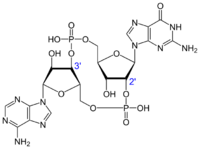Chemistry:Cyclic guanosine monophosphate–adenosine monophosphate

| |
| Names | |
|---|---|
| Other names
cGAMP; cyclic GMP-AMP; cGAMP(2'-5'); cyclic Gp(2'-5')Ap(3'-5')
| |
| Identifiers | |
3D model (JSmol)
|
|
| ChEBI | |
| KEGG | |
PubChem CID
|
|
| UNII | |
| |
| |
| Properties | |
| C20H24N10O13P2 | |
| Molar mass | 674.417 g·mol−1 |
Except where otherwise noted, data are given for materials in their standard state (at 25 °C [77 °F], 100 kPa). | |
| Infobox references | |
Cyclic guanosine monophosphate–adenosine monophosphate (cyclic GMP-AMP, cGAMP) is the first cyclic di-nucleotide found in metazoa.[1] In mammalian cells, cGAMP is synthesized by cyclic GMP-AMP synthase (cGAS) from ATP and GTP upon cytosolic DNA stimulation.[2] cGAMP produced by cGAS contains mixed phosphodiester linkages, with one between 2'-OH of GMP and 5'-phosphate of AMP and the other between 3'-OH of AMP and 5'-phosphate of GMP.[3][4][5][6]
This molecule, referred to as 2′3′-cGAMP (cyclic [G(2’,5’)pA(3’,5’)p]), functions as an endogenous second messenger inducing STING-dependent type I interferon response.[1][3] cGAMP has also been shown to be an effective adjuvant that boosts the production of antigen-specific antibodies and T cell responses in mice.[7] cGAMP exercises antiviral functions in the cell where it is produced, but can also cross cell membranes by passive diffusion through gap junctions to exert effects on neighboring cells.[8][9] It may even be packaged into lentivirus (such as HIV-1), poxvirus and herpes virus, and under cell culture conditions has been found to transmit an antiviral signal to the cells infected with these viruses; however, there is reason to think that at least HIV is capable of evading this mechanism by some means.[8] [9]
In recent years, cGAMP signalling has been identified in prokaryotes including Vibrio cholerae which express a bacterial analogue of cGAS. In these organisms, cGAS is encoded as part of an operon alongside cGAMP-activated phospholipases (e.g. CapV in V. cholerae). During infection by bacteriophage, cGAS is activated and cGAMP is synthesised, activating CapV which degrades the cell's membrane and triggers cell death before the phage can complete its replicatory cycle.[10]
References
- ↑ 1.0 1.1 Wu, J; Sun, L; Chen, X; Du, F; Shi, H; Chen, C; Chen, ZJ (Dec 20, 2012). "Cyclic GMP-AMP is an endogenous second messenger in innate immune signaling by cytosolic DNA.". Science 339 (6121): 826–30. doi:10.1126/science.1229963. PMID 23258412.
- ↑ Sun, L; Wu, J; Du, F; Chen, X; Chen, ZJ (Dec 20, 2012). "Cyclic GMP-AMP synthase is a cytosolic DNA sensor that activates the type I interferon pathway". Science 339 (6121): 786–91. doi:10.1126/science.1232458. PMID 23258413.
- ↑ 3.0 3.1 Zhang, X; Shi, H; Wu, J; Zhang, X; Sun, L; Chen, C; Chen, ZJ (Jun 3, 2013). "Cyclic GMP-AMP Containing Mixed Phosphodiester Linkages Is An Endogenous High-Affinity Ligand for STING". Molecular Cell 51 (2): 226–235. doi:10.1016/j.molcel.2013.05.022. PMID 23747010.
- ↑ Gao, P et al. (May 3, 2013). "Cyclic [G(2′,5′)pA(3′,5′)p Is the Metazoan Second Messenger Produced by DNA-Activated Cyclic GMP-AMP Synthase"]. Cell 153 (5): 1094–1107. doi:10.1016/j.cell.2013.04.046. PMID 23647843.
- ↑ Ablasser, A; Goldeck, M; Cavlar, T; Deimling, T; Witte, G; Röhl, I; Hopfner, KP; Ludwig, J et al. (Jun 20, 2013). "cGAS produces a 2′-5′-linked cyclic dinucleotide second messenger that activates STING". Nature 498 (7454): 380–384. doi:10.1038/nature12306. PMID 23722158.
- ↑ Diner, EJ; Burdette, DL; Wilson, SC; Monroe, KM; Kellenberger, CA; Hyodo, M; Hayakawa, Y; Hammond, MC et al. (May 23, 2013). "The innate immune DNA sensor cGAS produces a noncanonical cyclic dinucleotide that activates human STING". Cell Reports 3 (5): 1355–61. doi:10.1016/j.celrep.2013.05.009. PMID 23707065.
- ↑ Li, XD; Wu, J; Gao, D; Wang, H; Sun, L; Chen, ZJ (Sep 20, 2013). "Pivotal roles of cGAS-cGAMP signaling in antiviral defense and immune adjuvant effects". Science 341 (6152): 1390–4. doi:10.1126/science.1244040. PMID 23989956.
- ↑ 8.0 8.1 John W. Schoggins (2015-09-11). "Viruses carry antiviral cargo". Science 349 (6253): 1186–1187. doi:10.1126/science.aad0942. PMID 26359389.
- ↑ 9.0 9.1 Andrea Ablasser (2013-09-29). "Cell intrinsic immunity spreads to bystander cells via the intercellular transfer of cGAMP". Nature 503 (7477): 530–534. doi:10.1038/nature12640. PMID 24077100.
- ↑ Cohen, Daniel; Melamed, Sarah; Millman, Adi; Shulman, Gabriela; Oppenheimer-Shaanan, Yaara; Kacen, Assaf; Doron, Shany; Amitai, Gil et al. (October 2019). "Cyclic GMP–AMP signalling protects bacteria against viral infection" (in en). Nature 574 (7780): 691–695. doi:10.1038/s41586-019-1605-5. ISSN 1476-4687. PMID 31533127. https://www.nature.com/articles/s41586-019-1605-5.

